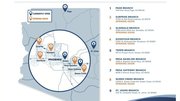News
Networks want FIs to feel in control
Some EFT networks are trying to gain a competitve edge by tweaking their governmental structures to give FI members more influence.
March 14, 2004
About 10 years ago, financial institutions began relinquishing control of EFT networks to third party processors, a calculated move on the FIs' part.
"It was part of a strategic decision to give up direct control of the networks. It was what [FIs] wanted at that time," said Les Riedl, executive vice president of the Atlanta-based consulting firm Speer & Associates.
FIs did not consider EFT networks a part of their core business, Riedl said.
"There was a realization at that time in the FI community that operating a network was operating a processing business. FIs did not want or need to control that," he said.
But now it appears that FIs might want to regain greater control over their network destinies.
Power plays
In October, Bob Whyte, who heads up Bank of America's ATM/merchant services program, offered advice on selecting a network during a presentation at the Thomson Financial ATM/Debit Forum in New Orleans.
In his speech, Whyte listed five criteria for selecting a payment network. In addition to such common-sense advice as ensuring networks have a broad geographic footprint and attractive pricing, he advised FIs to seek a governmental structure that offered them a chance to control their destinies.
Over the last few years, several EFT networks have restructured to, at least in theory, offer FIs greater say and control.
"The networks now want to demonstrate a competitive advantage to FI customers. So, what you see is networks creating formal structure to give customers more input," Riedl said. "Before this type of structure, [FIs] may not have thought their voice was loud enough."
Late last year, Brookfield, Wis.-based Fiservcreated what it called a hybrid approach to EFT governance for its Accel/Exchange network, with a 16-member network advisory council comprised of 15 FI members and one Fiserv representative.
"We established a governance structure in which members have the authority and are confident with us owning the majority of the network. We really did it to meet the concerns of our members," said Kevin Gregoire, senior vice president of products and networks for Fiserv.
Some members of other networks "do not feel they have a strong voice," Gregoire said.
According to a news release issued by Fiserv in November, although a small number of networks remain institution-owned, "they operate regionally and development resources and priorities can be contentious and inefficiently deployed."
"We strongly believe the model we have with authority resting with our members is the best model," Gregoire said. "Other networks should take a look at how they measure and weigh their own interests and the interests of their members."
The Star network, which became one of the first to break away from a financial institution-owned model when it was purchased by Concord EFS in 2001, has a member-based governance structure, not dissimilar to that offered by Fiserv.
Star, whose parent is in the midst of being acquired by First Data Corporation, has 97 advisory board members representing 47 different FIs.
"The fact of the matter is one of input and control," said Barbara Span, a Star vice president and spokesperson. "Star was owned by 47 FIs until 2001. When 47 FIs made the decision to sell Star to Concord, those FIs were represented on the [Star] advisory board. Today, 47 FIs are represented on a series of Star advisory boards."
Advisory boards "continue to be a part of the overall decision making process," Span said.
As Star customers, FIs have ownership in the rules and policies governing the network, Span said. "If you are a member customer of Star and we aren't serving you, then you are not going to be a member. That is what control is -- being a customer."
All things being equal
Despite a market move toward less overt control, there are still networks that champion a more traditional FI-owned model. Houston-based Pulse is a not-for-profit association owned and directed by a board of 25 FIs. Each member of the board has an equal vote, regardless of its size or transaction volume.
"We have an egalitarian structure and voting structure that represents all the viewpoints of all organizations of every size. There is a spirit among our board of directors for the greater good," said Stan Paur, Pulse's president and CEO.
The best testimony to the effectiveness of Pulse's decision making structure, said Paur: "We've never had a split or contentious vote. We encourage people to talk through issues. It has served us well."
Visa and MasterCard appear to see the changing network environment as an opportunity to more directly compete with the regional networks. While Visa is structured as an association model with members, MasterCard has shareholders rather than members, Riedl said. A number of large FIs sit on the boards or are shareholders of Visa and MasterCard.
"Look, some FIs think they don't need EFT network membership at all. They get that from Visa and MasterCard, who may have convinced banks to drop [EFT] membership completely," Riedl said. "Look at some of the large banks, they went with Visa. This absolutely impacts the EFT networks."
Indeed, Wells Fargo and Bank of America both pulled out of Star in 2003, choosing to give their ATM and debit business to Visa instead.
Noting that Fiserv is a major core processing provider to financial institutions, Gregoire said membership in Accel/Exchange makes access to cardholders' demand deposit accounts (DDAs) "as streamlined as possible."
"Through a connection to Accel/Exchange, the hops along the transaction pathway are reduced and the DDA is readily accessed," Gregoire said. "Visa and MasterCard debit transactions from Fiserv core processed issuers are coming to us anyway. Membership in Accel/Exchange simplifies the process and provides a robust authorization capability, outstanding performance metrics and, ultimately, our more efficient infrastructure."
Increased competition between Visa/MasterCard and regional EFT networks is a good thing, Riedl said.
"Competition serves everyone well," he said. "If there's bidding between Star and Visa for an FI's business, the FIs stand to gain the most. Because when you're negotiating prices and there's competition, there's only one direction the price will go."














